Pneumatic system
The pneumatic system is a system that shares many similarities with the electrical system, such as the ability to transmit and store energy, and the ability to convert energy. That’s why the compressed air system plays an important role in production for various industries.
In this article, I will try to provide you, the reader, with useful information related to the pneumatic system.
Understanding the pneumatic system
The pneumatic system is a combination of various compressed air equipment that are combined together to perform certain tasks or operations. The energy source provided for the system to operate the equipment and machinery is compressed air (air present in the Earth’s atmosphere, compressed to high density and pressure).
The common method of generating compressed air is by using various types of air compressors, which can be powered by electricity, gasoline, or diesel.
The pneumatic system has various practical applications, with the most common being in industrial production and on different types of vehicles and machinery. Depending on specific applications, the scale and complexity of the system will determine the operating pressure, which usually ranges from 1.5 bar to 10 bar. For heavy-duty industrial systems, the operating pressure can go up to 40 bar or higher.
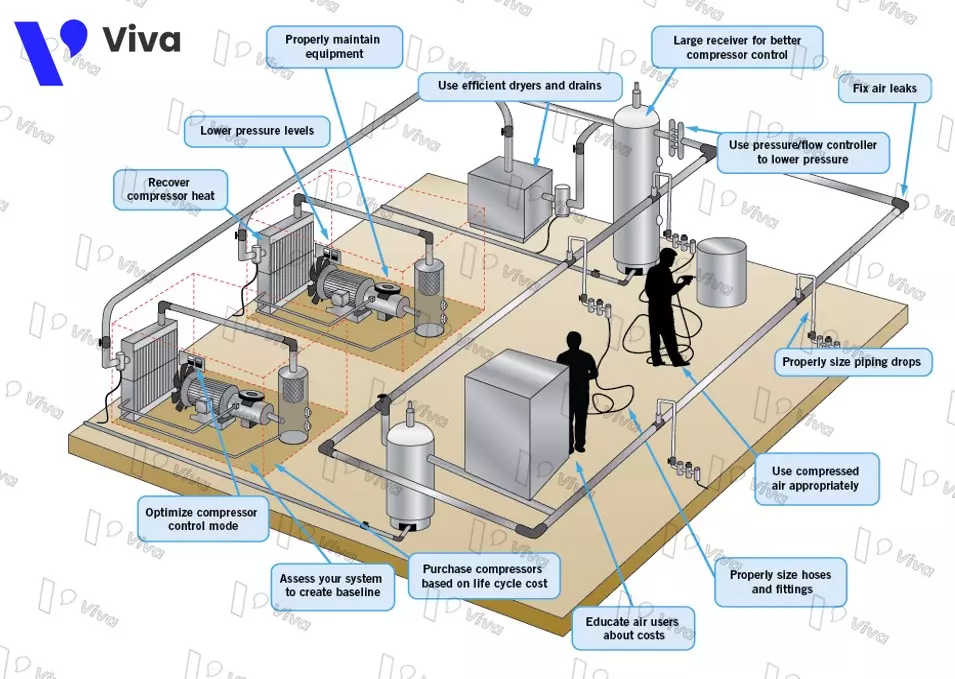
Main Components of the pneumatic system
For conventional pneumatic systems, regardless of their scale or complexity, they are generally composed of four main components:
- Air generation and storage: This is the starting point for all pneumatic systems. It includes one or a combination of air compressors (depending on the system’s power requirements). Air compressors are usually powered by electricity and they take in ambient air through specific compression mechanisms (such as screw, reciprocating piston, rotary vane, etc.) to compress the air into a fixed-volume receiver tank, thereby increasing the density and pressure of the air compared to the atmospheric conditions.
- Air distribution and regulation: After compressed air is generated by the air compressors, it needs to be distributed to various areas and types of equipment or machinery that use compressed air. To achieve this, the system requires components that perform the function of air distribution. This includes air distribution pipes, various types of valves, and fittings for connecting the pipes. Through these pipes, compressed air is delivered to different components throughout the facility and is controlled by regulating valves.
- Air utilization: This component consists of various devices, tools, or machinery that operate using the pressure of compressed air (such as pneumatic cylinders, air motors, pneumatic drills, etc.).
- Control components: To ensure that the pneumatic system operates according to our requirements, we need to control the system. This is achieved through a central control panel. The complexity of the control component depends on the level of automation. This component includes various sensors, electric or pneumatic control valves, etc.

Properties of Compressed Air
Compressed air is air that is compressed from the surrounding normal atmosphere. Because of this compression, the composition of compressed air is similar to regular air. Additionally, it possesses the following special properties.
High Pressure
Compressed air has a relatively high pressure. To provide an easy comparison, the pressure of the surrounding air we normally experience is around 1 bar. In contrast, the pressure of compressed air can range from 1.5 bar to several tens of bars or even higher, depending on the system.
High Molecule Density
Ordinary air contains various molecules, including oxygen comprising about 20.9%, nitrogen comprising about 78.09%, carbon dioxide comprising about 0.03%, and the remaining 0.93% consisting of argon and other gases. Additionally, ordinary air contains moisture and dust particles.
During the process of generating compressed air, machines and equipment are designed to remove moisture and dirt from the air while retaining other components. With the same amount of gas, after passing through the air compressor, it gets compressed and stored in pressure vessels, resulting in a significantly increased density of the compressed air.
Energy Storage Capability
Compressed air is a form of energy that can be stored. After being compressed by an air compressor, the compressed air is then conveyed through pipes and valves to undergo dust filtration and water separation within the system. By going through these components, clean compressed air meeting the system requirements is obtained.
However, compressed air is not used directly but stored inside pressure vessels. The larger the volume of the vessels, the greater the storage capacity for compressed air, which implies a higher amount of stored energy.
Circulation Capability within the System
Despite being compressed to high pressures and densities, compressed air retains the inherent characteristics of regular air. It can easily disperse to various locations within the system, and under the influence of high pressure, the compressed air is distributed to all components and devices in the pneumatic system more readily. This property is commonly referred to as high flexibility, as compressed air flows from areas of high pressure to areas of low pressure.
From there, the compressed air in the system is stored and then supplied to various types of pneumatic devices, which transform this compressed air into mechanical energy.
Commonly used devices in pneumatic systems
As mentioned at the beginning of the article, a pneumatic system is a combination of multiple compressed air devices. To better understand this issue, let’s find out what these devices are and their functions.
Air compressors
Air compressors in pneumatic systems have the task of generating a high-pressure compressed air flow. The compressor uses electrical energy, but there are also types of air compressors driven by gasoline engines or diesel engines to operate special mechanisms that produce high-pressure compressed air. The compressed air is then stored in pressure vessels.
Depending on the mechanism and principle of generating compressed air, air compressors can be divided into various types, including:
- Screw compressors
- Piston compressors
- Centrifugal compressors
- Scroll compressors, etc.
Depending on the type and size, air compressors provide different levels of power (often measured in horsepower) to evaluate the compressor’s capacity. For all pneumatic systems, selecting an air compressor with suitable capacity is crucial.
If the compressor has a lower working capacity than the consumption capacity of the devices in the system, it will lead to a shortage of compressed air, causing the system to operate unstably or even not function.
If the air compressor has a significantly higher capacity than the entire system’s consumption capacity, it will result in unnecessary waste. In this case, the initial cost of the equipment is very high. If we disregard factors such as brand and origin, the price of an air compressor is directly proportional to its capacity.
Translation:
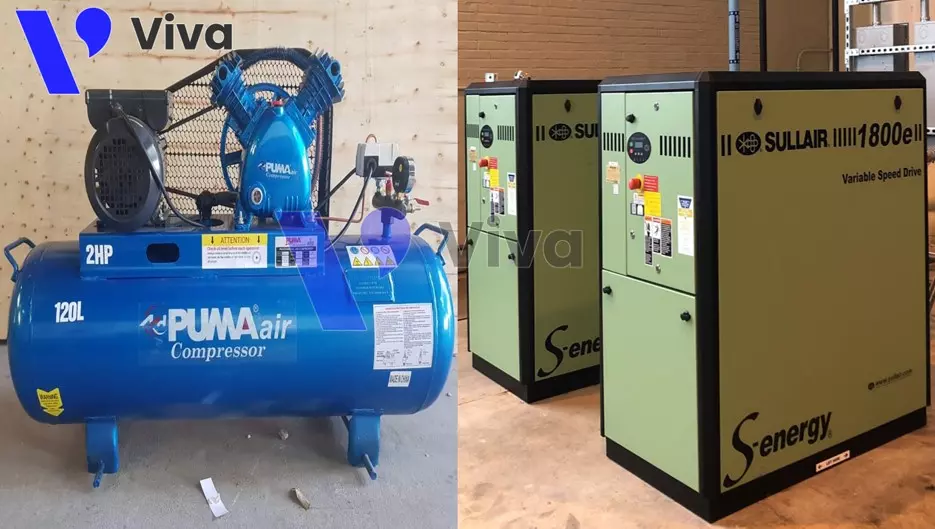
Compressed Air Hose and Connecting Accessories
Similar to an electrical circuit, compressed air needs to be delivered to various consuming devices to perform specific operations. Devices powered by compressed air are distributed throughout the system. In order for the compressed air to reach these devices, a network of compressed air distribution is designed, consisting of pipelines capable of withstanding the pressure of the compressed air. These pipelines are interconnected using various accessories such as couplings, hose connectors, fittings, etc.
The pipelines are provided in various materials and sizes. For systems requiring high power consumption and high pressure, larger-sized pipes with a diameter greater than 21 mm are commonly used, made of materials like zinc-coated steel pipes, galvanized steel pipes, copper pipes, etc. In practice, these pipes are used in central compressed air supply lines (main lines).
To increase flexibility during usage, compressed air from the main line is supplied to smaller-diameter hoses, typically 4 mm, 5 mm, 8 mm, etc. These hoses are collectively referred to as compressed air hoses. They allow the passage of compressed air, withstand pressure, exhibit high elasticity, and are usually made of materials such as PVC, PU, synthetic rubber.
The pipelines are also used for installing devices like control valves and compressed air filters.
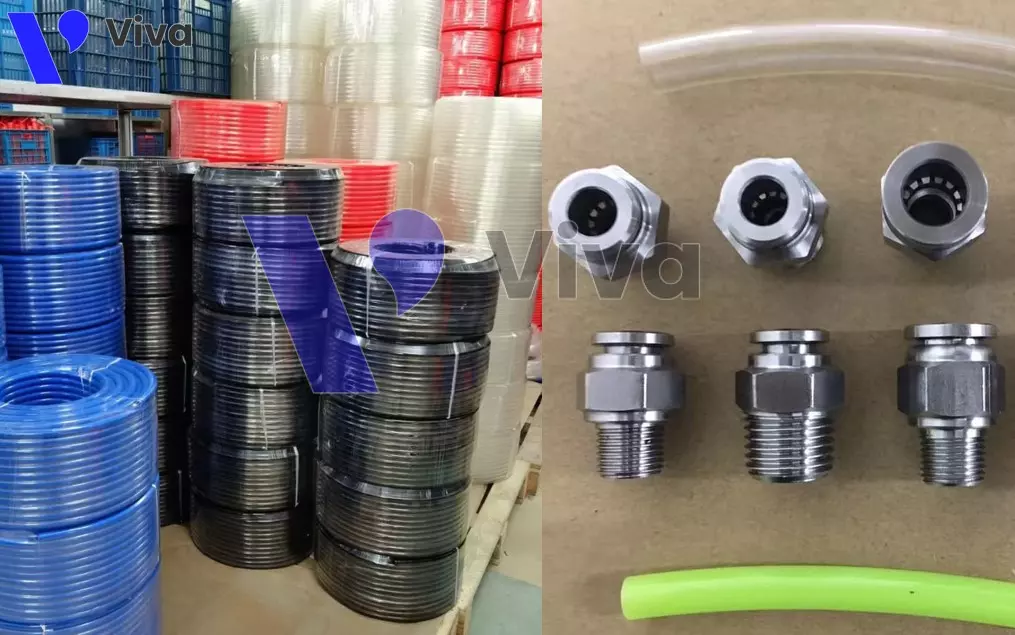
Types of Valves
Valves installed in pneumatic systems allow users to control the flow of compressed air within the pipelines. With the development of pneumatic systems, there are various types of valves used.
They provide functions such as opening and closing, flow regulation, and flow direction control for fluids, etc.
Corresponding to these functions, we have the following types of valves:
- Ball valve: This type of valve is designed to open or close the flow of compressed air. In some cases, it can also be used to regulate the compressed air. The valve can be operated manually through a lever or can be powered by electric or pneumatic actuators.
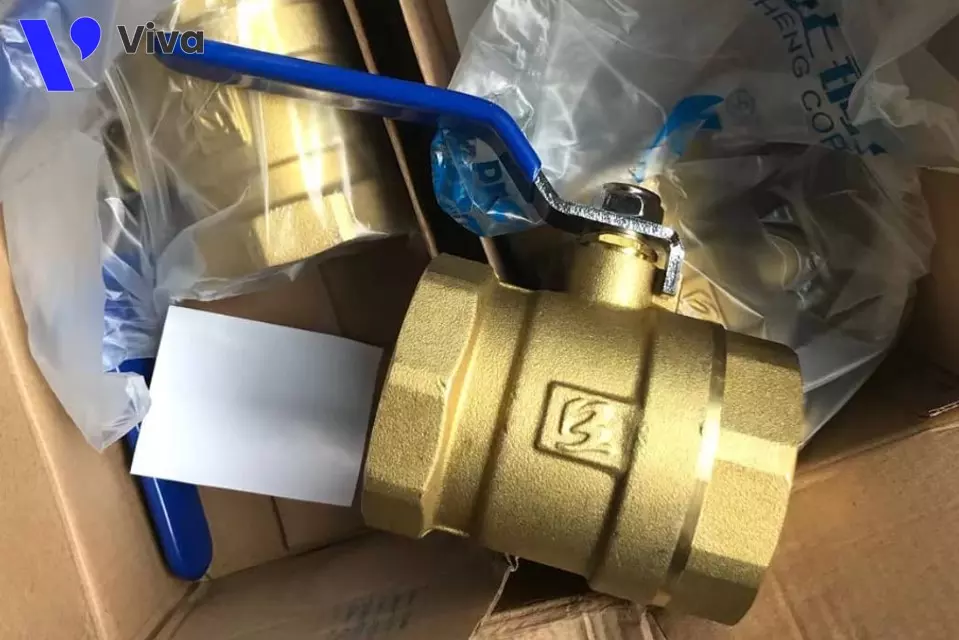
- Directional valve: Compressed air directional valve is used to control the direction of the compressed air flow. It has a special valve body that includes multiple air outlet ports, each connected to a different pipe end. Inside the valve body, there is a specially designed spool that, by changing its position, can alter the working positions of the valve.
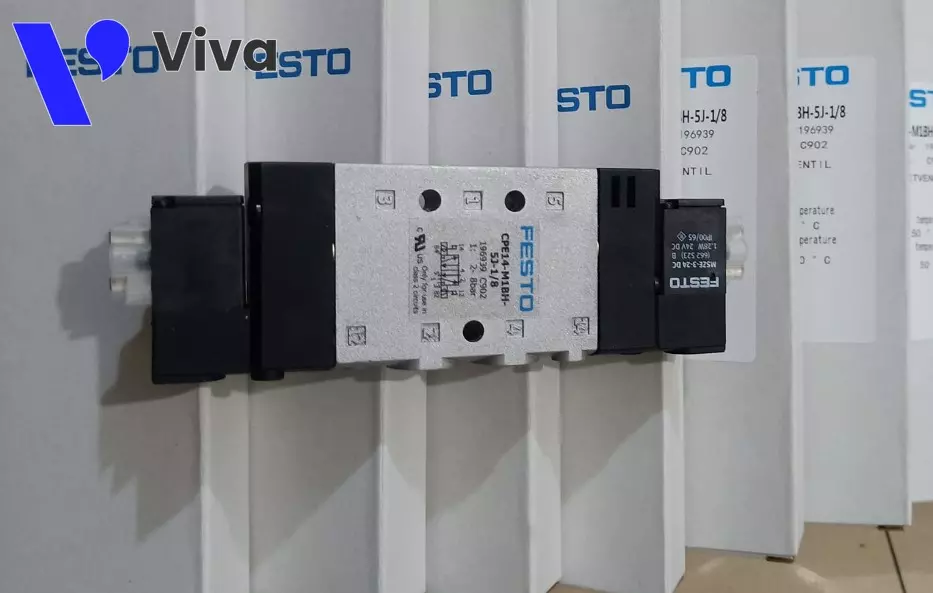
- Flow control valve: This device allows for the adjustment of the compressed air flow within a certain range as it passes through the valve. The flow control valve is directly installed onto the pipe.

- Pressure relief valve: This type of valve provides the ability to adjust the pressure of the compressed air after it passes through the valve. The valve body includes a pressure gauge that allows for more accurate adjustments. Pressure relief valves are often integrated into a cluster along with an air filter.
Here is a translation of the given text into English while keeping the HTML code intact:
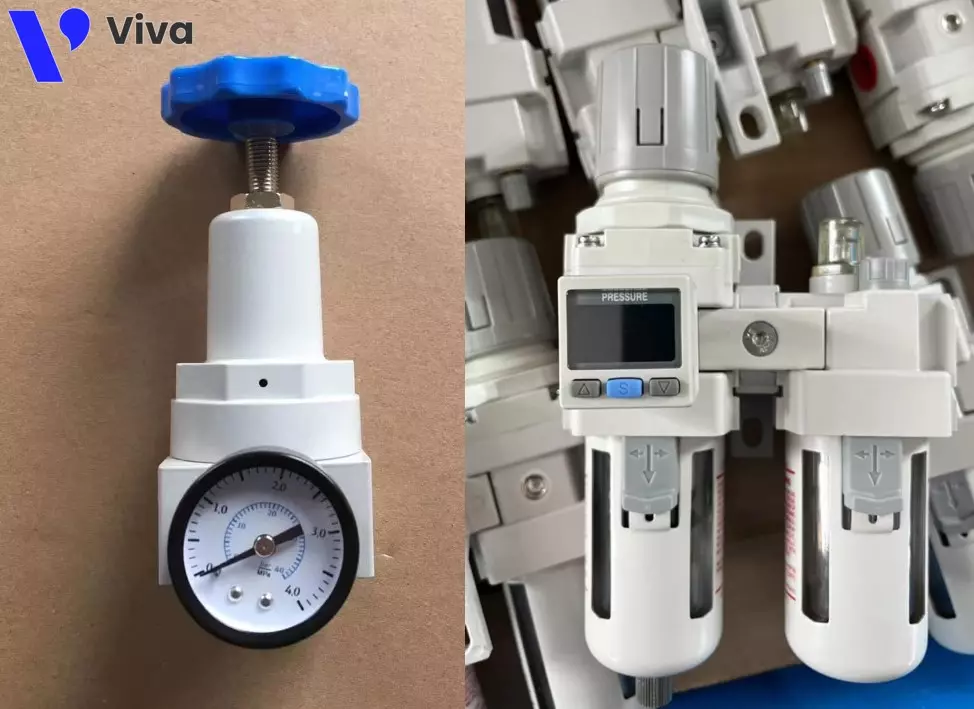
Above are some popular valve lines widely used in various pneumatic systems.
Compressed Air Consuming Devices
In a pneumatic system, common types of compressed air consuming devices include:
- Pneumatic cylinders: Devices that use high-pressure compressed air to generate mechanical motion. Some types of motion that pneumatic cylinders can provide include linear motion, 90° and 180° rotational motion, and clamping motion.
- Pneumatic motors: These are devices that use compressed air to convert pressure into motion. They are used as a substitute for electric motors in some cases.
- Air compressors: Air compressors essentially operate on the same principle as pneumatic cylinders, but they involve more components and have a more complex structure. Typically, these machines provide a high compressive force and are used for shaping mechanical products or household items.
- Pneumatic drills and screwdrivers: If an air compressor is an application of pneumatic cylinders, then pneumatic drills are products that apply the principle of pneumatic motors. Compressed air is supplied to the drill, and the pressure of the compressed air acts on the fan blade, causing it to rotate. The rotational motion of the fan blade is transmitted and transformed (mostly increasing torque and reducing rotational speed). The appropriately fast and sufficiently torque-rich rotational motion is then transmitted to the drill bit to directly impact the object being processed.

Sensor Devices and Control Devices
Various types of sensor devices and control devices are used in pneumatic systems to enhance the system’s automatic operation.
Typically, the more complex a pneumatic system is and the higher the level of automation required, the more types of sensor devices and control devices are used. Some commonly used sensor devices in pneumatic systems include:
- Pneumatic cylinder position sensors
- Inductive proximity sensors
- Optical object sensors, etc.
Quantity and types of sensors used in the system depend on the specific functions and applications of the system itself.

Monitoring devices
These are monitoring devices that display values related to the working parameters of the pneumatic system, helping users evaluate the system’s efficiency. With these parameters, it becomes easier to calculate and balance input costs.
Compressed air pressure gauge
The compressed air pressure gauge is usually directly attached to the pipeline where the compressed air is present. The pressure inside the pipeline affects the measurement mechanism of the gauge, which displays the pressure value on its face.
Pressure gauges are available with different pressure ranges, from 0 to 5 bar, 10 bar, and many devices up to hundreds of bars.
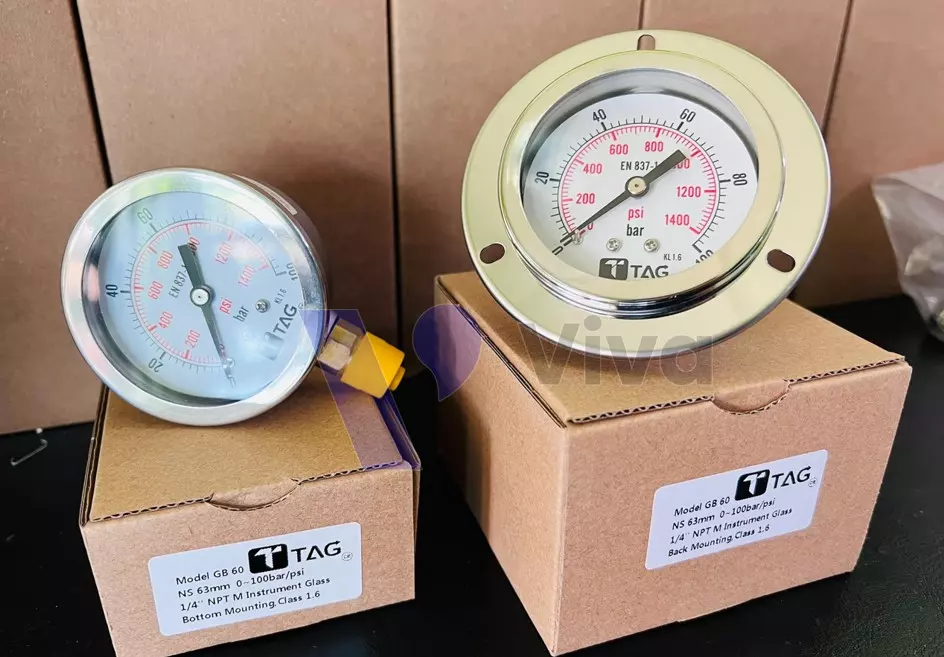
Compressed air flow meter
In Vietnam, it is noticeable that small and medium-sized pneumatic systems usually do not use flow meters due to their relatively high cost. However, in the long run, having at least one flow meter in the pneumatic system provides many benefits.
The main function of a compressed air flow meter is to provide a measurement of the airflow within the system. The flow value is displayed in units such as m³/h, m³/min, kg/h, tons/h, etc.
Based on the flow value, we can evaluate the level of compressed air consumption of the system or area, which allows for appropriate adjustments to meet the usage needs and assess the maximum and minimum production capacity that the system can achieve.
Suitable flow measurement instruments for pneumatic systems include:
- Mass flow meters
- Turbine flow meters
- Vortex flow meters.

Advantages and disadvantages of pneumatic systems
To understand the advantages and disadvantages of pneumatic systems, we need to compare them with a system that can provide similar features and is commonly used, in order to consider the detailed outstanding points and limitations of compressed air systems.
In many specific applications, both pneumatic systems and electrical systems are used for power transmission, including transmitting rotary motion and linear motion to components and mechanisms, allowing them to perform specific activities.
Advantages of pneumatic systems
pneumatic systems are widely used in various manufacturing and engineering applications. The reason for this popularity is that compressed air systems perform well in transmitting and converting energy, accompanied by numerous outstanding advantages such as:
- Safety: The safety evaluation criteria for compressed air are considered from two aspects, including environmental safety and safety for humans and equipment used in the system.
Regarding environmental aspects, compressed air mainly consists of regular air, and after a working cycle, the discharged compressed air will not have adverse effects on the environment.
Regarding equipment and humans, applying pneumatic systems in production is generally considered safer than electrical systems in many cases. First, we can limit the risk of accidents related to electricity (electric shock, fire due to overload) to a certain extent. However, it does not mean that compressed air systems never have accidents related to electricity. Here, due to the smaller number of electrical devices, the risk can naturally be reduced, although it is still important to adhere to safety principles for all systems. - Durability: Most devices and machinery in pneumatic systems are manufactured with a majority of mechanical components. As you may know, devices with predominantly mechanical structures tend to have much higher durability compared to electrical and electronic devices. Therefore, from a general perspective, compressed air systems are considered to have higher durability.
- Stable operation: Since a significant number of devices are manufactured entirely from mechanical components, the system has the ability to provide stable operation under various conditions (temperature changes, humidity, vibrations, etc.). This is an outstanding advantage when compared to electrical and electronic devices used in electrical systems, as they are directly affected by the aforementioned environmental factors.
Disadvantages of pneumatic systems
Although pneumatic systems are evaluated to have numerous outstanding advantages, they also have some limitations that we need to understand in order to consider a reasonable design option for the system.
Some existing limitations for these systems include:
- Initial investment cost: In most cases, a significant obstacle to building a compressed air system is the large initial investment cost. If the application scale of the system is not large enough and the system is not designed for long-term use, it is not advisable to use a pneumatic system.
- Noise: One disadvantage that has been present since the early days of application and development of compressed air systems is the noise generated during operation. Although some accessories have been used to limit this phenomenon, it cannot completely eliminate the noise generated. The loud noise produced during operation will directly affect the system operator.
- Connectivity: Compressed air systems are considered to have certain limitations in terms of connectivity with central control systems. However, this disadvantage has been almost completely overcome by using suitable sensors. However, this will generate additional costs and increase the complexity of the system.
Causes of Pressure Drop in pneumatic systems
During the initial design of compressed air systems, engineers calculate and design the system with appropriate operating capacity to meet the usage requirements (including overload reserve factors).
However, after prolonged use, the system may experience pressure drop, leading to unstable operation of the system or, worse, the inability to operate. So, what are the causes of this phenomenon and how can it be addressed?
Some common causes of compressed air loss include:
- Air leaks: For long-term systems, if a pressure drop occurs without significant changes in the system, such as installing additional high-consumption devices, the most common cause is air leaks. Leaks can occur in pipes, valves, compressed air devices, etc. Therefore, when we detect pressure drop in the system, the first step is to inspect the system to identify the location of leaks and then take appropriate measures to fix them.
- Replacement of incompatible equipment: In practical use, systems are prone to damage, and to fix them, we need to replace the faulty equipment with new ones. However, during the replacement process, it is possible to use equipment with inadequate technical specifications, which can lead to deviations in subsequent parameter values.
- Reduced performance of the air compressor: Like any machinery, over time, machines will gradually lose their performance. Air compressors are no exception to this rule. Prolonged operation of the equipment will result in wear and tear of the contacting parts due to friction. This wear and tear directly affect the machine’s performance. Therefore, during usage, regular inspection and evaluation of the air compressor’s performance are necessary to implement appropriate maintenance and replacement plans.
Maintenance of pneumatic system
Maintenance of the system is an important and necessary activity for all small and large pneumatic systems. Depending on the scale and modernity of the system, the maintenance workload can vary. The purpose of maintenance work is to maintain the stable operation of the system, with the longest possible service life.
Here are some important activities in the maintenance process of a compressed air system:
- Regular inspections: Perform regular inspections to determine the operational status of the system. Check compressed air pressure, air leaks, air duct structures, and control valves to detect malfunctions and potential issues.
- Oil replacement and cleaning: Regularly replace the air compressor oil and clean the oil filters to remove dust and impurities. This ensures the efficient operation of the air compressor and prolongs its lifespan.
- Filter inspection and replacement: Regularly inspect and replace compressed air filters, including oil filters, solid filters, and air filters. This helps remove contaminants from the compressed air, protecting equipment and tools from damage.
- Control valve inspection: Inspect and maintain control valves to ensure their accurate operation and prevent air leaks.
- Pressure vessel inspection: Evaluate the energy storage operation of the pressure vessel, regularly performing condensate drainage operations.
These are the essential activities to be carried out in the maintenance of a pneumatic system. However, these are just basic activities that you can refer to. In practice, maintenance should be based on specific systems to develop more flexible and appropriate procedures.

Applications of pneumatic system
pneumatic systems are applied in various fields, particularly in industries related to heavy manufacturing, due to the convenience, safety, and cost savings that compressed air systems can provide while performing equivalent functions.
Some applications of compressed air systems include:
- Automotive manufacturing industry: pneumatic systems are present in all factories and production lines for manufacturing automotive equipment and components. In this context, compressed air systems are used to operate various types of machinery and tools, including screwdrivers, drilling machines, paint sprayers, and mechanical mechanisms.
- On certain types of vehicles: Currently, pneumatic systems are used in various types of transportation vehicles, depending on their design and specific functions. For example, compressed air systems are used for opening and closing mechanisms in public transportation vehicles, as well as for pneumatic braking systems in cars and trains.
- Food processing industry: In large-scale automated factories, compressed air systems are always present to provide operational energy for specific devices and mechanisms. These systems, combined with sensors and central computer control systems, can operate with a high level of automation.
These are just a few small examples that demonstrate the application scope of pneumatic systems. Through this, it is hoped that readers have gained a comprehensive understanding of the importance of compressed air systems and what they can achieve.
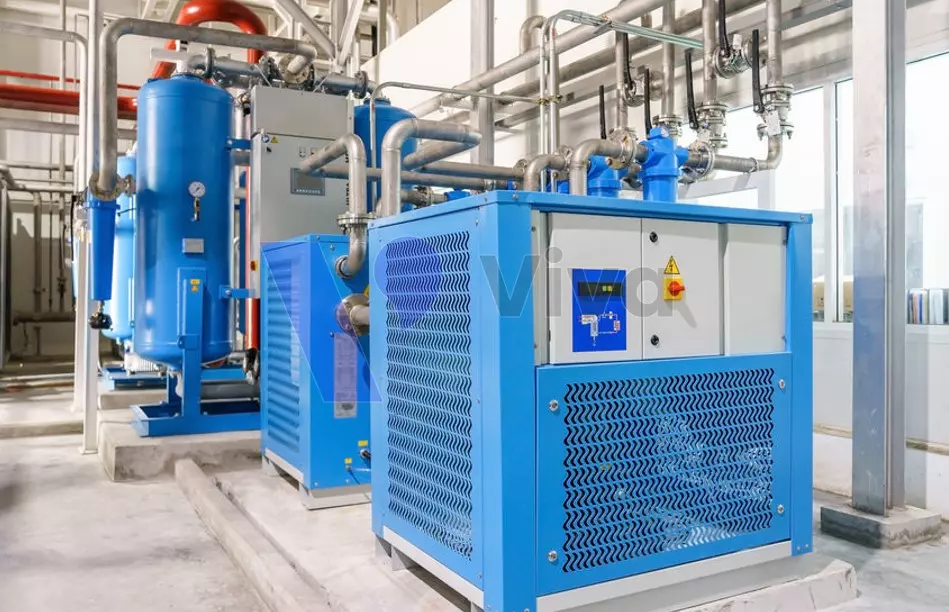
Conclusion
In this article, we have clarified the concept of pneumatic systems, the types of components used in these systems, their applications, and the advantages and disadvantages of compressed air systems.
Overall, the compressed air system provides solutions for various tasks if designed appropriately. The system is highly regarded for its stability and efficiency, especially when invested in on a large scale and used in the long term.
In addition, factors such as high safety standards and the durability and stability of the equipment used in the pneumatic system make it applicable in most heavy industries.

Finally, on behalf of the VIVA team, I would like to thank our valued readers for taking the time to read this article. We greatly appreciate your comments, contributions, and any related questions you may have.
